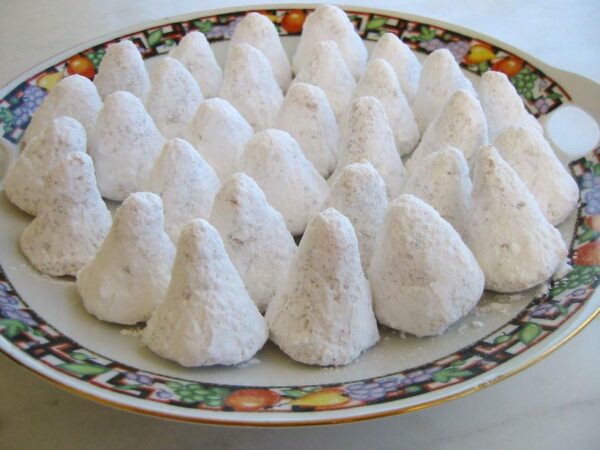The Aristocratic Sweet of Greek Tradition
Amygdalota, traditional Greek almond confections, are among the most refined offerings in Greek pastry-making. Made primarily with ground almonds and fragranced with rose water or orange blossom water, these delicate, fragrant treats are timeless symbols of joy, hospitality, and celebration. Often served during weddings, baptisms, and other significant life events, amygdalota hold a cherished place in Greek culinary tradition.
📜 History and Symbolism
The history of amygdalota stretches back centuries, with roots in the broader Mediterranean and Middle Eastern world—regions where almonds have long been prized for their rich flavor and symbolic meaning. In Greek culture, these sweets became closely associated with purity, happiness, and good fortune, which explains their presence at joyful, ceremonial occasions.
Their pale white colour—whether from blanched almonds or a dusting of powdered sugar—evokes elegance and simplicity. In many regions, they are offered at weddings as a thoughtful alternative or addition to sugared almonds (koufeta), symbolising heartfelt wishes for a sweet life.
🌸 Ingredients and Aromas
Though recipes vary, the foundation of amygdalota is simple. What sets them apart is the quality of ingredients and regional variations in flavour.
Basic Ingredients:
-
Ground blanched almonds
-
Sugar
-
Rose water or orange blossom water
-
Egg whites (optional, depending on the recipe)
Optional Enhancements:
-
Chios mastic
-
Citrus zest (lemon or bitter orange)
-
Spices: clove, cinnamon, or vanilla
-
Breadcrumbs, semolina, or honey (in some local recipes)
These ingredients are combined into a soft, pliable dough, which is then shaped into elegant bite-sized pieces—often teardrops, flames, or rounds—and either gently baked or left to air-dry. A final dusting of powdered sugar completes the sweet.
🏝️ Regional Variations: A Sweet Journey Across Greece
Across Greece, each region puts its own stamp on the amygdaloto, resulting in a mosaic of unique flavours and textures:
-
Spetses: Perhaps the most famous version—flame-shaped, aromatic, and often considered the gold standard.
-
Andros & Syros (Cyclades): Known for their soft texture and generous use of blossom water.
-
Chios: Distinctive for its use of mastic and subtle floral notes.
-
Crete: Slightly baked, resulting in a firmer, crunchier bite, often scented with lemon.
-
Rhodes: Soft and chewy, with pronounced floral aromas.
-
Kymi, Hydra, and Monemvasia: Also renowned for their distinctive takes on the sweet, each using regional ingredients and techniques passed down through generations.
🍽️ Traditional Recipe: Cycladic Amygdalota
Ingredients:
-
500g blanched and ground almonds
-
250g sugar
-
2 egg whites (lightly beaten)
-
2 tbsp orange blossom water
-
Powdered sugar for dusting
Instructions:
-
In a mixing bowl, combine the ground almonds and sugar.
-
Add the orange blossom water and gradually incorporate the egg whites until a soft, moldable dough forms.
-
Shape the dough into small forms—traditionally, teardrops or flames.
-
Place them on a parchment-lined baking tray.
-
Bake in a preheated oven at 300°F (150 °C) for 10–15 minutes. They should not brown.
-
Let them cool completely and dust generously with powdered sugar.
💬 A Sweet That Blends Tradition and Emotion
Amygdalota are more than just a treat — they are edible heirlooms, passed down through generations. Their delicate flavour, refined aroma, and elegant appearance make them ideal for both festive and intimate occasions. Whether enjoyed with a coffee during a quiet afternoon or offered to guests as a welcoming gesture, amygdalota remain a symbol of Greek filoxenia—the sacred art of hospitality.
Whether you prefer the traditional version or a modern twist with chocolate or liqueur infusions, amygdalota continue to charm with their timeless appeal and deep cultural roots.
Photo: Mycenaean Earth Estate of the Athanasopoulos Farm




